This blog post is devoted to the brilliant works of James Herriot, an English veterinarian and writer renowned for his captivating tales of rural life. His stories, which blend the magical simplicity of country existence with fascinating insights into animal care, have become global bestsellers.
For new readers or those revisiting Herriot’s world, we will provide an in-depth look at the author, and outline the ideal order in which to enjoy his extensive literary portfolio.
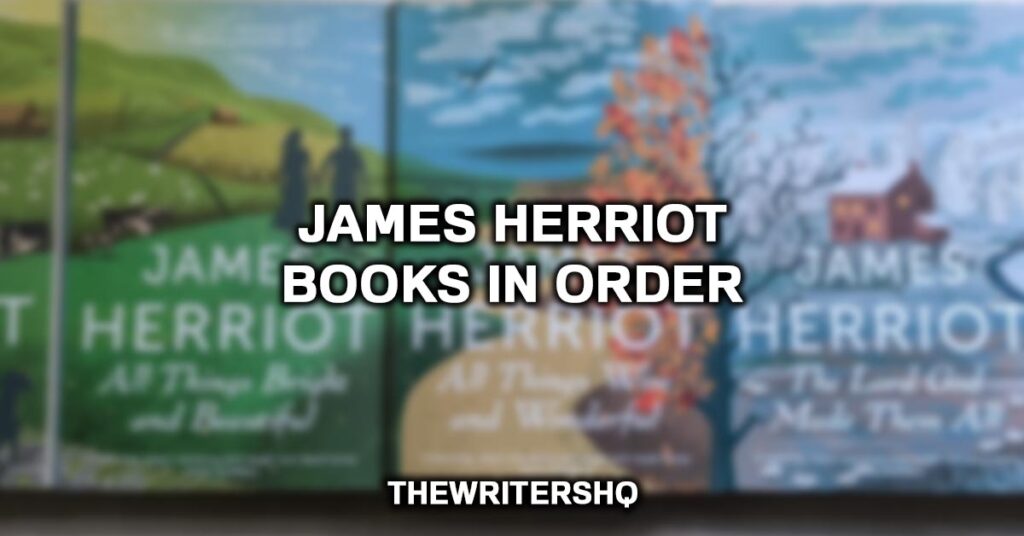
Who is James Herriot?
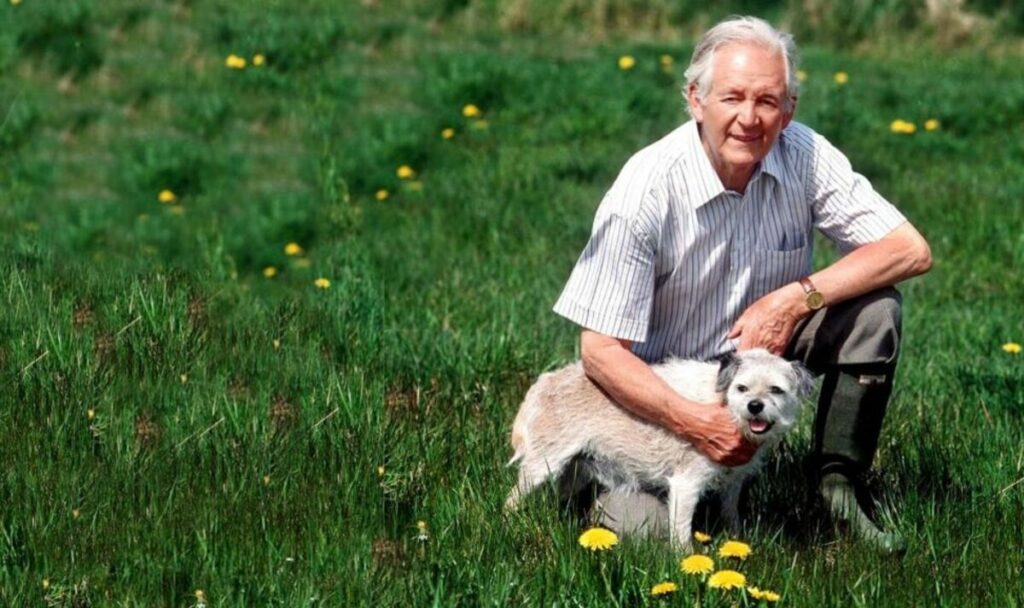
Born as James Alfred Wight in Sunderland, England, in 1916, James Herriot was both a highly respected veterinary surgeon and a distinguished author. His pen name, James Herriot, would come to be known worldwide.
Quick Fact: Herriot’s stories primarily revolve around his experiences as a vet in Yorkshire, offering heartwarming and often humorous tales filled with endearing characters – both human and animal.
In the 1940s, Herriot began his career in Thirsk, a small town in Yorkshire. His experiences treating animals in the English countryside during this period served as the foundation for his future writings. His books not only offer a profound understanding of veterinary science but also beautifully capture the landscape, culture, and charm of rural life in Yorkshire.
How To Read the James Herriot Books In Order
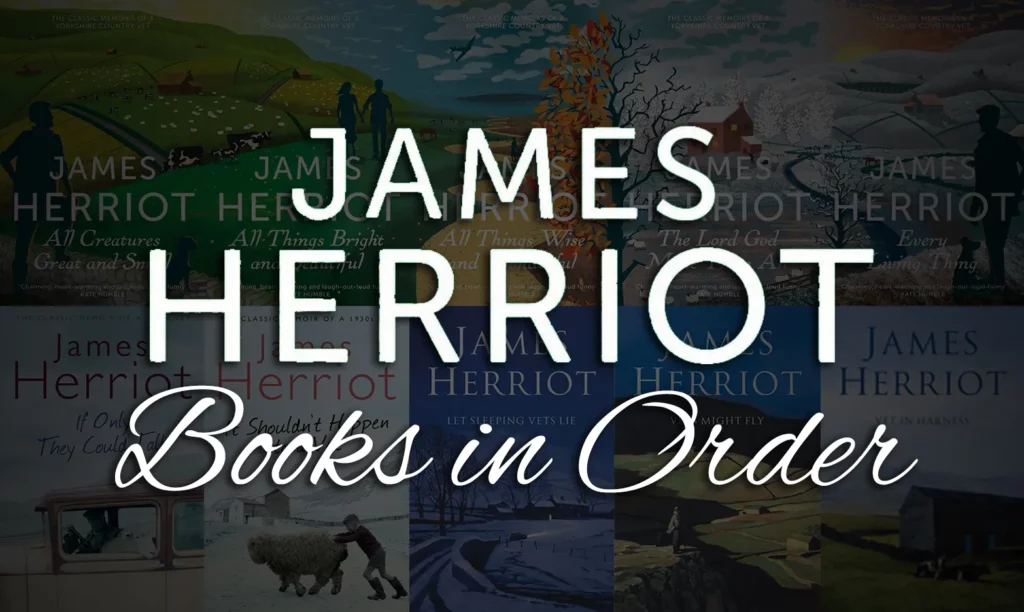
Herriot’s books were not originally published in chronological order, but here’s a list to read them as per the timeline of events they depict:
- “If Only They Could Talk” (1970)
- “It Shouldn’t Happen to a Vet” (1972)
- “Let Sleeping Vets Lie” (1973)
- “Vet in Harness” (1974)
- “Vets Might Fly” (1976)
- “Vet in a Spin” (1977)
- “The Lord God Made Them All” (1981)
- “Every Living Thing” (1992)
In addition to these, Herriot also published a series of short-story collections that aren’t tied to a specific timeline. These include “James Herriot’s Yorkshire” (1979), “The Best of James Herriot” (1982), and “James Herriot’s Cat Stories” (1994), among others.
Please note that the first two books, “If Only They Could Talk” and “It Shouldn’t Happen to a Vet,” along with some additional stories, are also combined into a single volume called “All Creatures Great and Small.”
Similarly, the third and fourth books, “Let Sleeping Vets Lie” and “Vet in Harness,” along with more stories, are compiled into “All Things Bright and Beautiful.” The next two, “Vets Might Fly” and “Vet in a Spin,” are combined in “All Things Wise and Wonderful.”
Whether you choose to read the books individually or the combined volumes, James Herriot’s world is bound to draw you in, one story at a time.
Summary for each book
1. “If Only They Could Talk” (1970)
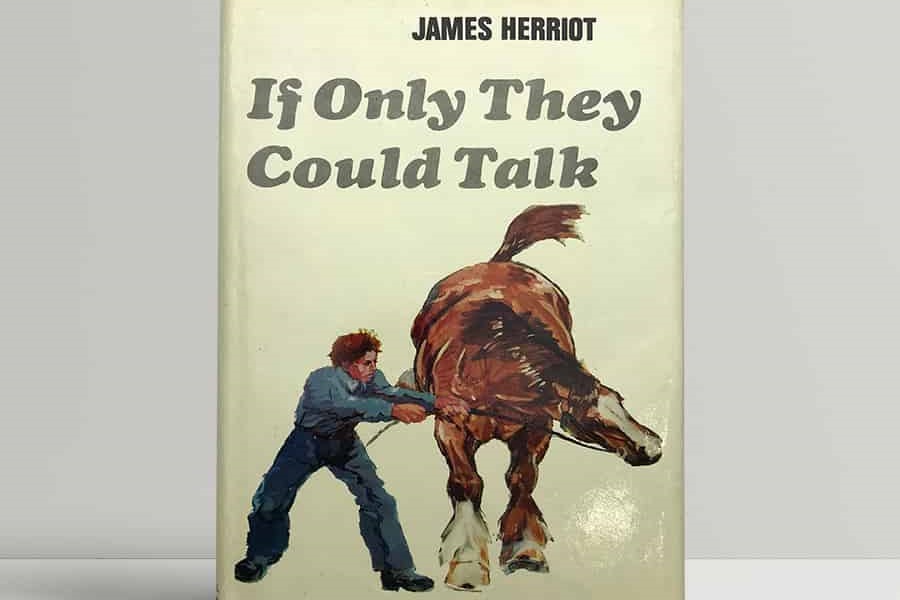
“If Only They Could Talk” is the first book of Herriot’s series and introduces us to his journey as a young, newly qualified vet moving to the Yorkshire Dales in the late 1930s. The book opens with Herriot’s arrival in the small market town of Darrowby and his introduction to his peculiar employer, Siegfried Farnon, and Siegfried’s charming yet forgetful brother, Tristan.
It covers the ups and downs of his first year in practice, focusing on his interactions with eccentric clients and a variety of animals, ranging from horses and cows to pets. Herriot’s transition from city life to the countryside, complete with its unique customs and challenges, is portrayed with warmth, humor, and genuineness.
2. “It Shouldn’t Happen to a Vet” (1972)
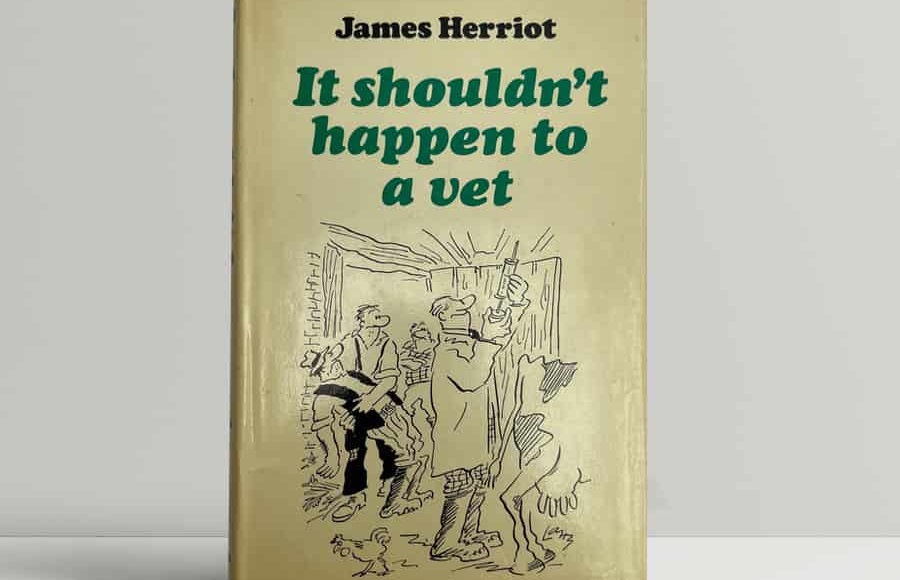
Continuing where “If Only They Could Talk” left off, “It Shouldn’t Happen to a Vet” delves deeper into Herriot’s life as a vet in the Dales. By now, he is more accustomed to the quirks of his clients and their animals and is continually surprised and amused by his experiences. There are endearing episodes involving the local farmers, challenging cases, and memorable pets.
Amidst all this, Herriot’s love interest, Helen Alderson, is introduced, leading to some charming and funny situations. The book concludes with Herriot and Helen’s engagement, creating anticipation for the next installment in the series.
3. “Let Sleeping Vets Lie” (1973)
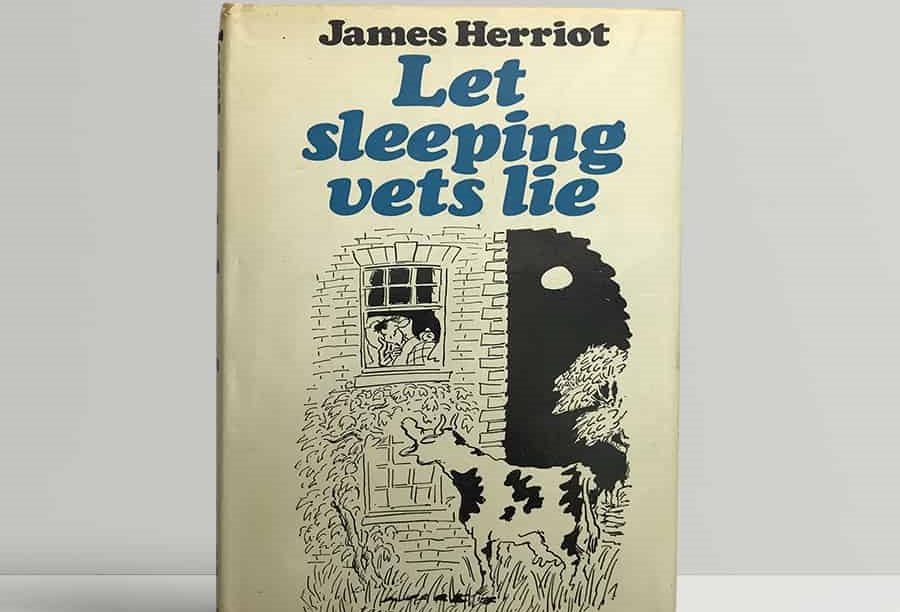
In “Let Sleeping Vets Lie,” Herriot has gained more confidence in his veterinary skills and deepened his roots in Darrowby. The book contains more of Herriot’s escapades as a country vet and his relationship with Helen. There are stories involving midnight emergencies, farm visits, and some extraordinary animal characters.
Herriot’s encounters with the Yorkshire people, the often challenging weather, and the beautiful landscape of the Dales are painted vividly. At the end of the book, Herriot marries Helen, marking another significant milestone in his life.
4. “Vet in Harness” (1974)
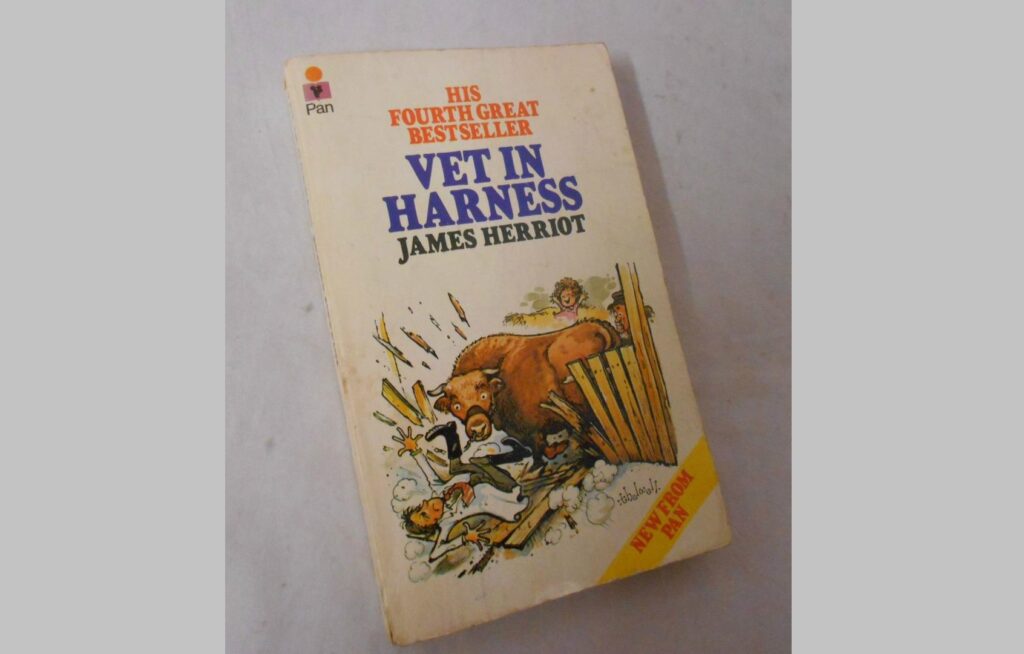
“Vet in Harness,” also known as “All Things Bright and Beautiful,” sees Herriot adjusting to married life while handling his busy veterinary practice. It showcases his compassion and love for animals and people, despite the sometimes demanding nature of his work.
Herriot’s tales of delivering lambs in the middle of a snowstorm, treating an array of pets, and managing peculiar clients with humor and kindness are all part of this rich tapestry of country life. There are continued moments of humor between Siegfried and Tristan, showing the deepening bonds between them.
The book ends on a dramatic note, with Herriot being called up for the RAF (Royal Air Force), leaving the tranquil Dales for the uncertainties of war.
5. “Vets Might Fly” (1976)
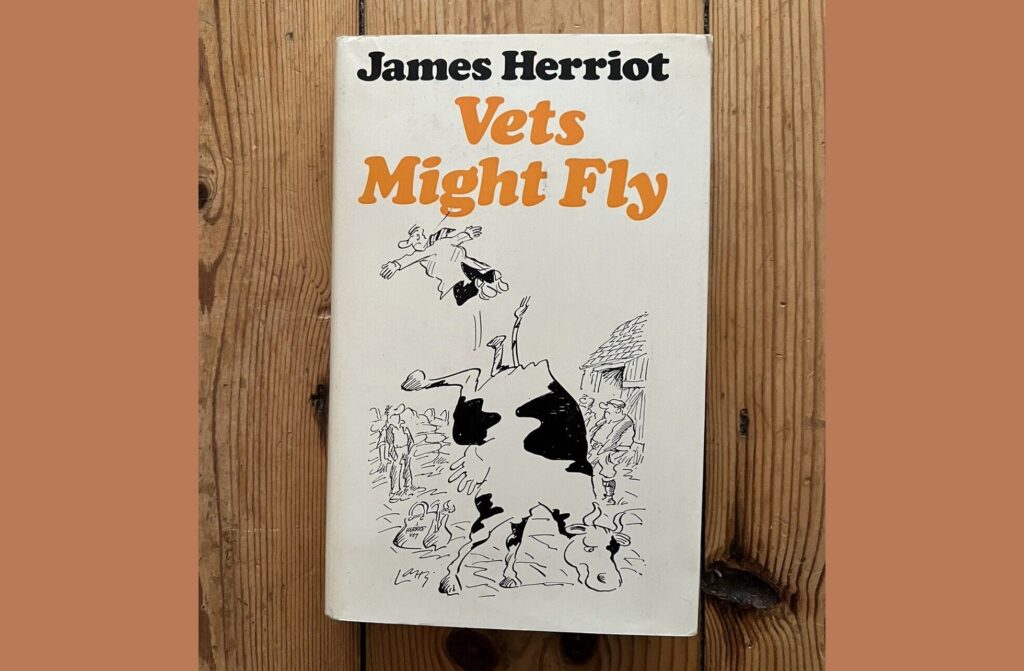
“Vets Might Fly” commences with James Herriot being enlisted in the Royal Air Force during World War II. The book steps away from the Yorkshire Dales and into the new territory of airfield life, where Herriot must adapt to a different pace and structure.
Despite the new setting, Herriot maintains his warm storytelling style, regaling readers with amusing stories of his fellow recruits and the various animals he encounters on the base. The book concludes with Herriot’s return to civilian life, to his practice, and to his beloved Dales.
6. “Vet in a Spin” (1977)
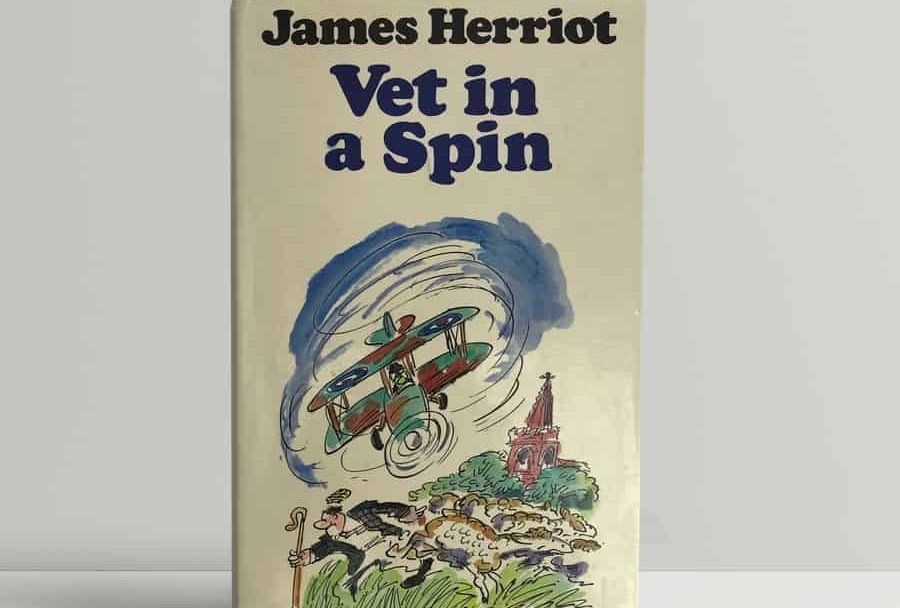
“Vet in a Spin” picks up where “Vets Might Fly” left off, focusing on Herriot’s final days in the RAF. The narrative recounts his training to become a pilot, filled with humorous anecdotes and touching interactions. However, the idyllic countryside and the challenges of veterinary practice are never far from Herriot’s mind.
After his discharge, Herriot returns to the Dales, back to his friends, family, and the animals that hold a special place in his heart. It’s a joyous reunion, marking the end of an era and the beginning of the next chapter in his life.
7. “The Lord God Made Them All” (1981)
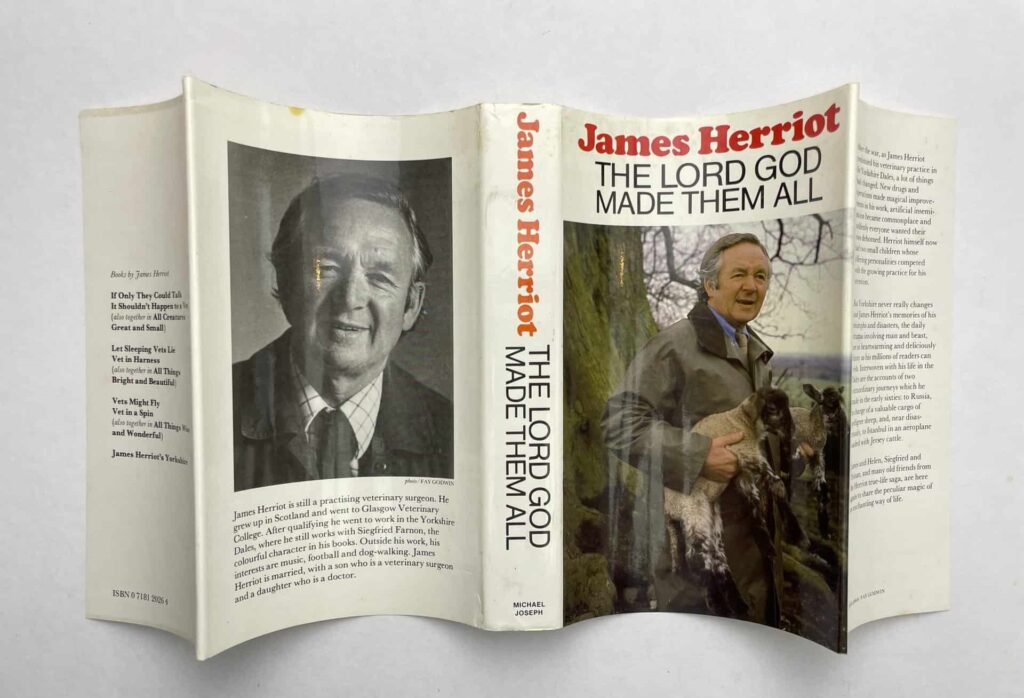
In “The Lord God Made Them All,” Herriot is back in Darrowby and readjusts to civilian life after the war. The book delves into his experiences in the evolving field of veterinary medicine during the 1950s and 1960s. We see Herriot navigate changes in his personal and professional life as he and Helen start a family.
The narrative retains its humor and charm, despite addressing some serious issues such as technological changes in farming and advancements in veterinary medicine. As always, the Yorkshire countryside, the locals, and their animals remain central to Herriot’s heartwarming stories.
8. “Every Living Thing” (1992)
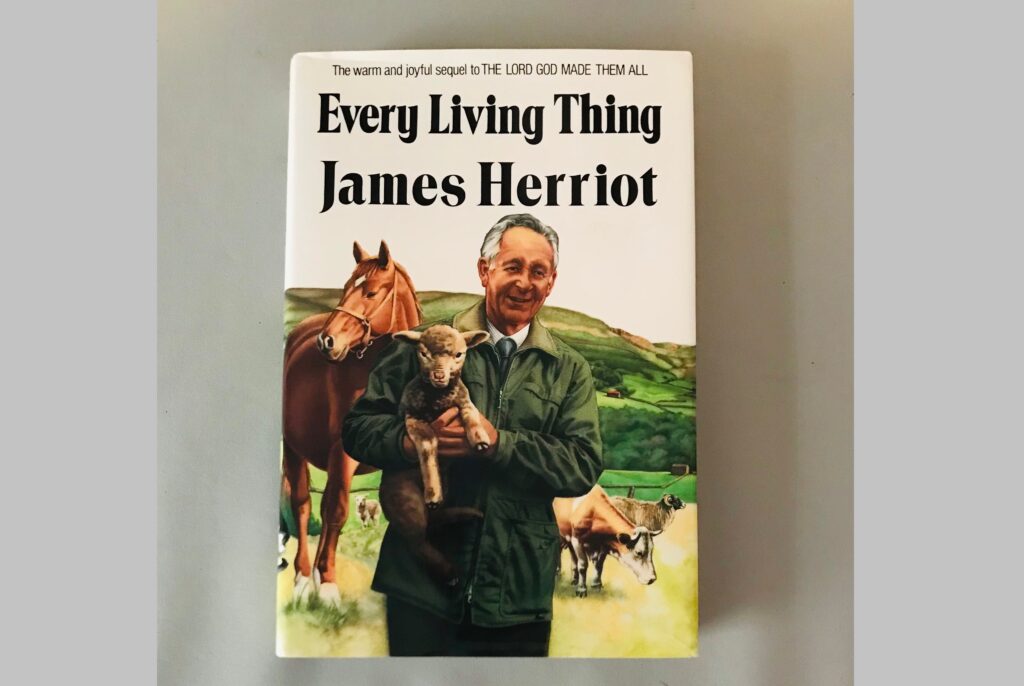
In “Every Living Thing,” Herriot continues his tales from the Yorkshire Dales, now in the midst of changing times. He and Helen have two children, and the veterinary practice is busier than ever. The book offers a mosaic of stories featuring new characters alongside old favorites.
His relationships with animals and their owners are as heartwarming and engaging as ever, and his love for his work shines through. Despite the passage of time and the evolving landscape of veterinary practice, Herriot remains the same humble, dedicated, and compassionate country vet that readers have come to adore.
This book is a testament to his lifelong devotion to animals and their welfare.
How Many James Herriot Books Are There?
James Herriot wrote a total of eight main books in the “All Creatures Great and Small” series, along with several other collections and children’s books. These include collections of short stories such as “James Herriot’s Yorkshire,” “The Best of James Herriot,” “James Herriot’s Cat Stories,” and “James Herriot’s Dog Stories.”
Quick Fact: He also wrote a variety of books specifically for children, such as “Moses the Kitten,” “Oscar, Cat-About-Town,” and “Bonny’s Big Day.”
How Many Books Are There of All Creatures Great and Small?
The term “All Creatures Great and Small” can refer to two things in the context of James Herriot’s work. It is the title of one of his most popular books, which is a compilation of his first two novels, “If Only They Could Talk” and “It Shouldn’t Happen to a Vet,” along with a few additional stories.
However, “All Creatures Great and Small” is also often used to refer to the entire series of eight books that follow Herriot’s life and veterinary experiences in the Yorkshire Dales. These are:
- “If Only They Could Talk”
- “It Shouldn’t Happen to a Vet”
- “Let Sleeping Vets Lie”
- “Vet in Harness”
- “Vets Might Fly”
- “Vet in a Spin”
- “The Lord God Made Them All”
- “Every Living Thing”
Which James Herriot Book to Read First?
If you’re new to James Herriot’s works, it’s best to start with the book “If Only They Could Talk,” which is the first in his series. This will introduce you to his world, the Yorkshire Dales, and the many colorful characters within it.
However, as mentioned above, “All Creatures Great and Small” combines “If Only They Could Talk,” “It Shouldn’t Happen to a Vet,” and a few additional stories into one volume. Therefore, “All Creatures Great and Small” is also an excellent starting point for new readers.
What is the Best James Herriot Book?
Determining the “best” James Herriot book is subjective, as it depends on personal preference. However, “All Creatures Great and Small” is often cited as a fan favorite. It encompasses the early period of Herriot’s veterinary career and introduces readers to the charming universe he inhabits. The book is a wonderful blend of humor, warmth, and fascinating veterinary tales.
What Age Should You Read James Herriot Books?
Herriot’s books are generally suitable for all ages due to their wholesome content and universally relatable themes. However, the primary “All Creatures Great and Small” series might be better appreciated by readers aged 12 and above due to its length and some complexity in language and veterinary terminology.
For younger readers, Herriot also wrote several children’s books. These shorter tales, with their engaging animal characters and captivating illustrations, are designed to be understood and enjoyed by children. Examples include “Moses the Kitten,” “Oscar, Cat-About-Town,” and “Bonny’s Big Day.”
Reading these stories can be a wonderful way for younger children to begin exploring the world of James Herriot.
Who were some of the notable characters in James Herriot’s books, and what role did they play in his stories?
James Herriot’s books are full of unforgettable characters, both human and animal, which lend a charming and authentic flavor to his stories. In terms of human characters, Siegfried Farnon and his younger brother Tristan Farnon are integral to the series.
Siegfried is Herriot’s employer and later partner in the veterinary practice, and he is characterized by his eccentricities, impulsive nature, and occasional forgetfulness.
Despite this, Siegfried is a competent vet and a good-hearted individual. His brother Tristan is a young, often mischievous vet-in-training, whose antics add a layer of humor and camaraderie to the narratives.
Then there’s Helen Alderson, who becomes Helen Herriot. She is Herriot’s love interest in the early books and later his wife. Helen is portrayed as a kind, understanding, and strong woman who often provides a counterbalance to Herriot’s work-related anxieties and dilemmas.
As for the animal characters, they are too many to enumerate.
From tricky calving and lambing cases in the middle of harsh winters to a wide variety of pets like dogs, cats, and birds, each animal has a unique personality and plays a significant role in Herriot’s stories.
How does James Herriot capture the essence of Yorkshire Dales in his books?
Herriot’s love for the Yorkshire Dales is a prominent aspect of his books. He paints a vivid picture of the rolling hills, lush pastures, and quaint villages that make up the region. His descriptions of the changing seasons, the harsh winters, and the blossoming springs lend a poetic feel to the backdrop against which his stories unfold.
But it’s not just the physical landscape that Herriot captures. He also portrays the culture and the people of Yorkshire with affection and authenticity. The locals, with their strong dialect, unique customs, and hardy spirit, come alive in his stories.
He describes their daily lives, their struggles and joys, their community gatherings, and their deep connection with their animals and the land.
How does Herriot’s work as a vet influence his storytelling?
Herriot’s veterinary practice forms the heart of his storytelling. His stories are derived from his real-life experiences as a country vet, dealing with various animals and their ailments. He delves into the science behind his work but always in a way that is understandable and relatable to non-veterinary readers.
His work also provides him with a wealth of diverse characters and situations. From challenging farm calls in the middle of the night to amusing encounters with pets and their owners, each day brings something new. Through these experiences, Herriot explores themes of compassion, dedication, and the rewards and challenges of veterinary practice.
How does Herriot’s writing style contribute to the success of his books?
Herriot’s writing style is straightforward, warm, and infused with gentle humor. His narratives have a conversational tone that makes the reader feel like they’re sitting down with him, listening to his anecdotes over a cup of tea.
He describes his experiences with sincerity and does not shy away from sharing his failures and mistakes along with his successes, which lends authenticity to his storytelling.
Additionally, Herriot’s descriptions are vivid and detailed, whether he’s painting a picture of the Yorkshire landscape or explaining a complex veterinary procedure. His stories are filled with emotion, moving effortlessly between moments of tension, humor, and heartwarming tenderness.
What themes are explored in James Herriot’s books?
There are several recurring themes in Herriot’s books. One of the primary ones is the love and respect for animals. Herriot’s care and compassion for animals, whether they’re pets or farm animals, shine through in all his stories.
Another theme is the beauty and challenges of rural life. Through Herriot’s experiences in the Yorkshire Dales, readers get an intimate look at the realities of living and working in the countryside, from the harshness of the winters to the camaraderie of the small-town community.
Quick Fact: Herriot’s books also explore the nature of veterinary practice. They highlight the joys and difficulties of the profession, the evolution of veterinary medicine, and the deep satisfaction of helping animals and their owners.
How did James Herriot’s books evolve over time?
Herriot’s books follow a chronological sequence, mirroring his life from a newly graduated vet to an experienced practitioner and family man. In the early books, Herriot is finding his feet, dealing with the challenges of rural practice, and navigating his personal life. As the series progresses, Herriot becomes more settled in his work, marries Helen, and starts a family.
The later books see him joining the RAF during World War II, adapting to a completely different environment, and then returning to his practice in the Dales. There’s an evolution in his storytelling too, as his experiences widen and he gains more insight into his work and the world around him.
How have James Herriot’s books impacted popular culture?
James Herriot’s books have had a significant impact on popular culture. They have sold millions of copies worldwide and have been translated into many languages, making Herriot one of the best-known veterinary authors.
His stories have been adapted into successful TV series, the most famous of which is “All Creatures Great and Small,” which first aired in the 1970s and 80s and was rebooted recently. The TV adaptations have introduced Herriot’s stories to a broader audience and have significantly influenced how people perceive the profession of a veterinarian.
Moreover, his books have inspired many people to pursue careers in veterinary medicine and have increased awareness and understanding of animal care among the general public.
Can you delve deeper into the role of humor in James Herriot’s books?
James Herriot’s books are often noted for their gentle, sometimes wry, humor. The humor comes from a variety of sources. Firstly, there are unpredictable situations that arise in veterinary practice, especially in a rural setting, which often lead to unexpected and amusing outcomes.
Herriot portrays these incidents with a keen sense of the absurd and a clear appreciation for the unexpected quirks of life.
Secondly, the distinct and colorful characters contribute to the humor. The eccentricities of Siegfried Farnon, the often hilarious escapades of his younger brother Tristan, and the idiosyncrasies of the local farmers and pet owners, all provide fertile ground for comedy.
However, the humor in Herriot’s books is never cruel or disparaging.
It arises from a place of affection and understanding for his characters and their foibles. It serves to add warmth and humanity to his stories, making them even more engaging and relatable.
What was James Herriot’s influence on the field of veterinary medicine?
James Herriot, through his books, has had a considerable impact on the field of veterinary medicine. His stories have popularized the profession and inspired countless readers to pursue a career as a veterinarian.
By sharing his experiences, Herriot has provided insight into the challenges and rewards of the job, promoting an understanding of the dedication, compassion, and knowledge required in this field.
Furthermore, his detailed accounts of veterinary procedures, treatments, and advancements in the field have educated the public, promoting better care and understanding of animals. His emphasis on kindness and respect towards animals has helped foster a more humane approach toward animal care and welfare.
How do James Herriot’s books portray the human-animal bond?
Herriot’s books showcase the profound and varied relationships between humans and animals. From the farmers who depend on their livestock for their livelihoods to the families who cherish their pets, Herriot highlights the deep emotional bonds that can exist between humans and animals.
He presents an array of scenarios of pets providing companionship and comfort, working animals serving crucial roles in farming and transportation, or animals inspiring admiration for their resilience or behavior. Through these relationships, Herriot explores themes of empathy, respect, companionship, and the rewards and responsibilities of caring for another life.
What role does the Yorkshire Dales play in Herriot’s narratives?
The Yorkshire Dales is much more than just the setting of Herriot’s books; it is an integral part of his stories. The rugged landscape, the changeable weather, and the distinct seasons of the Dales all impact the lives of the characters and the nature of Herriot’s veterinary work.
Herriot’s vivid descriptions of the landscape, its flora and fauna, and the farming practices adapted to its conditions bring the Dales to life. The tight-knit communities, the local dialect, and the customs and traditions of the region provide a rich cultural context to his stories.
The Dales, with their beauty and their challenges, shape the lives of their inhabitants and form the backdrop against which the drama of Herriot’s tales unfolds.
How does Herriot balance the technical aspects of veterinary medicine with engaging storytelling?
Herriot skillfully manages to incorporate the technical details of veterinary medicine into his stories without overwhelming the reader or detracting from the narrative flow. He explains the procedures and the medical terms in an understandable way, often using analogies and simple language.
His emphasis is always on the story, the animal, and the outcome, rather than the technical details.
Moreover, he uses these technical aspects to enhance his storytelling. The tension of a difficult diagnosis, the challenge of a complex procedure, or the satisfaction of successful treatment all contribute to the narrative arc of his stories. Through Herriot’s perspective, veterinary medicine is not just a technical field, but a blend of science, compassion, and everyday drama.
What is the emotional tone of James Herriot’s books?
Herriot’s books have a warm, uplifting emotional tone. Despite the challenges, difficulties, and occasional heartbreaks that come with his job, Herriot’s love for his work and his respect for animals shines through. His stories are filled with compassion, humor, and a deep appreciation for life in all its forms.
While there are moments of sadness, such as the loss of an animal, these are treated with sensitivity and are often balanced by hopeful or positive outcomes. The overall impression is of a world where kindness, dedication, and a sense of community can overcome adversity.
How do James Herriot’s books reflect the societal and technological changes of their time?
Herriot’s books, spanning several decades, offer a glimpse into the societal and technological changes of the mid-20th century. As a rural vet, Herriot witnesses the transformation of farming practices with the advent of new technologies. He discusses the impact of these changes on the animals, the farmers, and the landscape.
Similarly, advancements in veterinary medicine, such as new treatments and improved understanding of diseases, feature in his stories. Herriot navigates these changes with adaptability and an eagerness to learn.
World events like World War II also find their way into his narratives, showcasing how such global occurrences could affect the quiet life in the Dales.
In conclusion, James Herriot’s books offer a captivating blend of engaging storytelling, warm humor, fascinating veterinary insights, and vivid portrayal of rural life in the Yorkshire Dales.
His tales, filled with memorable characters and poignant observations, have entertained millions of readers worldwide and enriched our understanding and appreciation of the veterinary profession, the human-animal bond, and the beauty and challenges of life in the countryside.
For anyone seeking a heartwarming read that offers a window into a bygone era and a different pace of life, the works of James Herriot come highly recommended.
